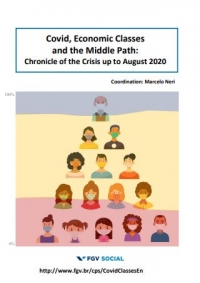
Covid, Economic Classes and the Middle Path: Chronicle of the Crisis up to August 2020
About the research:
An empirical assessment on Brazilian economic classes based on factual data collected during the Covid-19 pandemic shows that the number of poor Brazilians has decreased by 15 million individuals between 2019 and August 2020 (considering poor those individuals with per capita income below ½ minimum wage). This represented an impressive fall of 23.7% in poverty rates, steeper than in previous periods of social boom in the country, such as after monetary stabilization plans (e.g. the Cruzado plan in 1986 and the Real plan in 1994), reducing the number of poor people in Brazil to a new historical low of 50 million individuals. At the other end of the income distribution, the upper-income bracket that comprises people with at least two minimum wages per capita has diminished by 4.8 million people during the pandemic. The combination of these changes observed at the basis and the top of the distribution with a population increase of 1.6 million people led to an increase in the intermediary income group. Thus, the middle-income segment in Brazil has grown by approximately 21.5 million people, almost half of Argentina’s population. The reductions observed in both ends of the distribution occurred due to the combination of the negative economic effects of the pandemic with the measures taken by the government to mitigate them, such as the implementation of emergency grants targeted at the poor (Auxílio Emergencial) or at formal workers (Benefício Emergencial de Preservação do Emprego e Renda that adjusts working hours keeping hourly wage rates). We also noticed a larger poverty reduction in the North (27.5%) and Northeast (30.4%) regions, which contain the highest share of beneficiaries of the Auxílio Emergencial.
When looking at the variation in the size of the economic classes in time, we noticed that around 13.1 million individuals were out of poverty from 2019 up to July 2020 despite the sharp reduction in income from labor in the first complete quarter of the pandemic (-20.5%) - especially for the Brazilians at the bottom half of the income distribution (-27.9%) - a paradox explained by the emergency grants. Only in August two million Brazilians have additionally got above the poverty line. By contrast, the top part of the income distribution lost 5.8 million people up to July 2020 but it has received 1 million people back in August. As a consequence of these changes, the intermediary block has increased by 1 million people from July to August. This expansion in the so-called Class C (i.e. low middle class) occurred due to a partial recovery observed in the labor market and the emergency grants. In its peak, the Auxílio Emergencial reached 67 million people, costing R$ 322 billion in 9 months, a sum that represents 9 times the Bolsa Família’s annual cost, following the government’s budget proposal for 2021. This summary covering three economic classes in two moments in time is only the beginning of the crisis. Official government cash transfers for the Covid pandemic from now on offer only half of the original benefit before being terminated on December 31st. If nothing is done, in 2021 we are going to have a contigent equivalent to half of Venezuela’s population back to poverty due to the end of emergency grants and the scars in the labor market linked to the pandemic’s negative permanent impacts on jobs.
In addition to these income changes, the PNAD COVID household surveys analyse people’s behaviour concerning the pandemic. The poorest segment of the population, which is eligible to the Emergency Grant (i.e. Auxílio Emergencial) offered by the government, presents the lowest rates of social isolation, for example, in August, 6.15% of the individuals in this group remained strictly isolated and 40.7% only left their homes in case of necessity – rates that are lower than for the average Brazilian. These results suggest that the Emergency Grant has impacted the income of the target population but was not able to affect their behaviour regarding the social distancing challenge imposed by the pandemic.
I Executive Summary
I Video - 3'39'' (In Portuguese)
I Map - % of people by per capita household income bracket (minimum wage classes) - Changes between July and August 2020
I Map - % of people by per capita household income bracket (minimum wage classes) - Changes between 2019 and July 2020
I Map - % of people by per capita household income bracket (minimum wage classes) - August/2020




